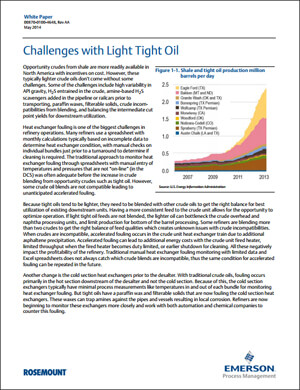I received an email of a new whitepaper, Heat Exchanger Challenges with Light Tight Crude! written by Emerson’s Tim Olsen. Tim is a consultant on our refining industry team and has shared his expertise in numerous refining-related posts here on the blog.
 The rapid growth of shale oil (tight oil) production in North America brings along its set of challenges for refineries. Tim notes some of the challenges:
The rapid growth of shale oil (tight oil) production in North America brings along its set of challenges for refineries. Tim notes some of the challenges:
…high variability in API gravity, H2S entrained in the crude, amine-based H2S scavengers added in the pipeline or railcars prior to transporting, paraffin waxes, filterable solids, crude incompatibilities from blending, and balancing the intermediate cut point yields for downstream utilization.
Refiners face an issue with heat exchanger fouling and have traditionally used manual entries and spreadsheets to monitor for fouling conditions.
Tim explains that tight oils are often blended with other crude sources because they are lighter:
If light tight oil feeds are not blended, the lighter oil can bottleneck the crude overhead and naphtha processing units, and limit production for bottom of the barrel processing. Some refiners are blending more than two crudes to get the right balance of feed qualities which creates unknown issues with crude incompatibilities.
Incompatibilities lead to heat exchanger fouling. This fouling increases energy usage, throughput limitations, and more frequent shutdowns for cleaning. All impact overall profitability of the refining operations.
Tim describes other challenges with the cold section of the heat exchangers where paraffin waxes and filterable solids cause fouling.
Moving beyond manual monitoring can help reduce these fouling conditions. Tim notes:
Typically there are temperature measurements in and out of a group of heat exchangers; what are lacking are measurements in-between tube bundles. Fouling across the bundles is not linear, so determining which bundle is fouled and needs cleaning can be difficult to determine without all the process measurements like temperature, flow, and differential pressure.
IEC 62591 WirelessHART measurement devices can be added to monitor for heat exchanger fouling. Download the whitepaper to see how these measurements, combined with an asset management strategy can provide the advanced warning to bring on spare equipment and address the heat exchanger fouling conditions before they impact refining operations.
You can connect and interact with Tim and other refining experts in the Refining track of the Emerson Exchange 365 community.





